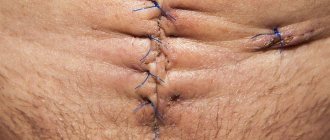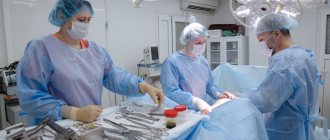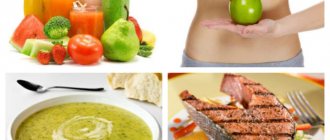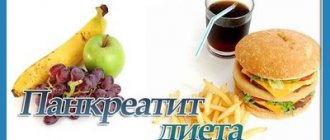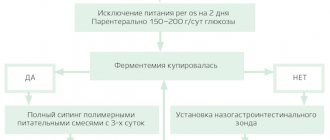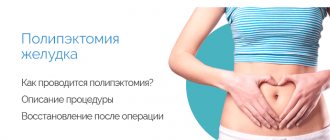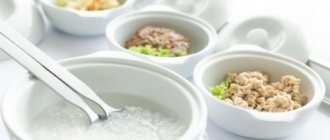Modern clinical medicine is armed with powerful pharmacological agents of pathogenetic therapy that can block the progression of many pathological processes that form inflammatory and dystrophic lesions of the digestive tract.
At the same time, a fairly large list of indications for surgical interventions on the gastrointestinal tract remains.
The surgical technique of surgical treatment of diseases of the digestive organs has reached a high level, and the individualization of the approach to the choice of surgical method has been developed.
However, operations performed after a longer or shorter period of time in a number of patients lead to various forms of postoperative disorders that require correction of treatment and individualization of the diet.
One of the main components of postoperative rehabilitation of patients who have undergone operations on the digestive organs is therapeutic nutrition, which largely satisfies the plastic and energy needs of the body, helping to reduce the incidence of complications and faster recovery.
The most important task of diet therapy, both in the inpatient and outpatient stages of rehabilitation (especially the first 2-3 weeks of rehabilitation treatment), is considered to be overcoming protein, vitamin, mineral and energy deficiency, which develops in many patients due to insufficient nutrition in the first days and even weeks after surgery, blood loss, fever.
Introduction
Over the past decades, continuous improvement of surgical approaches and improvement of methods of perioperative care for patients with esophageal cancer after esophagectomy with simultaneous plastic surgery has reduced postoperative mortality to 1% in specialized centers [25, 28]. However, the incidence of postoperative complications remains quite high, which increases the length of the patient’s postoperative hospital stay and the cost of treatment [16, 19].
The accumulated large amount of research and experimental material in the study of the perioperative period allowed the Danish professor Henrik Kehlet and a group of like-minded people to put into practice the concept of accelerated recovery after surgical interventions - Fast-track surgery or ERAS (Enhanced Recovery After Surgery), using which the process of restoring the body and adapting to new living conditions after major surgery can be reduced from several weeks to several days [21, 46, 47]. This requires the participation of motivated professionals who, using a team approach, will develop a perioperative protocol/algorithm for step-by-step surgical treatment, and then provide prevention and treatment of pain, active mobilization and rapid restoration of digestive functions.
The key role of the anesthesiologist in implementing a program for rapid recovery and rehabilitation of a surgical patient is the possibility of using in the perioperative period a set of measures to reduce the body’s surgical stress response and control postoperative pain, including regional methods of anesthesia/analgesia with local anesthetics, which significantly improves the quality of the treatment [8 , 45].
The active introduction of minimally invasive approaches to esophageal cancer surgery in the RCOD of the Ministry of Health of the Republic of Tajikistan has become an additional factor in reducing the perioperative surgical stress response, which provided an initiative group of specialists (including an anesthesiologist, surgeon, radiologist and therapist) with the opportunity to test the concept of accelerated recovery of the patient after esophagectomy with one-stage plastic surgery.
The purpose of our report is to provide information about our experience with a rapid recovery program after esophageal surgery.
Nutrition for patients after esophageal surgery
Patients who have undergone surgical treatment of diseases of the esophagus and gastroduodenal zone are transferred to outpatient treatment, as a rule, no later than 1.5-2 months after surgery.
This is usually preceded by rehabilitation treatment in a surgical hospital, where the operation was performed, and then in the gastroenterology department, where the patient goes for follow-up treatment, and in some cases in a sanatorium-type rehabilitation department. Diet therapy is an important part of the entire complex of postoperative rehabilitation of patients who have undergone surgery on the esophagus. For 4-6 months of the outpatient rehabilitation stage, a diet is prescribed, the characteristics of which are given in table. 40.1, 40.2.
Table 40.1. Characteristics of the diet for patients who have undergone esophageal surgery at the post-hospital stage
| general characteristics | A physiologically complete diet with a high protein content, normal fat content, with a limitation of mechanical and chemical irritants of the mucous membrane of the esophagus and stomach and the receptor apparatus of the gastrointestinal tract, with a maximum limitation of nitrogenous extractives, refractory fats, fat breakdown products, with the exception of strong stimulants of bile secretion and secretion of the pancreas and intestinal glands, with limitation of table salt | |
| Diet | Fractional 5-6 times a day | |
| Cooking: | Steaming, pureeing | |
| Food temperature | Hot dishes less than 50-60 °C; cold dishes over 15 °C | |
| Chemical composition: | ||
| squirrels | 140 g | |
| fats | 110-115 g | |
| carbohydrates | 380 g | |
| energy intensity | 3000 kcal | |
| free liquid | 1.5 l | |
| general characteristics | A physiologically complete diet with a high protein content, normal fat content, with a limitation of mechanical and chemical irritants of the mucous membrane of the esophagus and stomach and the receptor apparatus of the gastrointestinal tract, with a maximum limitation of nitrogenous extractives, refractory fats, fat breakdown products, with the exception of strong stimulants of bile secretion and secretion of the pancreas and intestinal glands, with limitation of table salt | |
| Diet | Fractional, 5-6 times a day | |
| Cooking: | Steamed, pureed | |
| Food temperature | Hot dishes less than 50-60 °C; cold dishes over 15 °C | |
| Chemical composition: | ||
| squirrels | 140 g | |
| fats | 110-115 g | |
| carbohydrates | 380 g | |
| energy intensity | 3000 kcal | |
| free liquid | 1.5 l | |
| Recommended: | ||
| Milk and dairy products - milk with tea and other products or as part of various dishes, if tolerated - whole milk; kefir is included 2.5-3 months after surgery; sour cream only as a seasoning; non-sour cottage cheese, freshly prepared, pureed Vegetables and greens - boiled and pureed vegetables; cauliflower only, boiled with butter, stewed zucchini and pumpkin, carrot, beetroot, mashed potatoes Fruits, berries, sweets - natural fruits and berries, fresh and dry in the form of unsweetened pureed compotes, jelly, jellies, mousses; baked apples, without sugar, non-acidic varieties; Fruits and berries with coarse fiber (pear, quince, persimmon) are not allowed; you can give compotes, jelly with xylitol, but sugar, honey, jam are limited Cereals and pasta - unsweetened, pureed, viscous porridges, puddings, casseroles made from rice, whole grains, rolled oats; pasta only finely chopped, boiled Fats — butter, ghee, sunflower, refined; do not fry, but add to dishes in their natural form Snacks - mild grated cheese (Dutch, Soviet, Russian, athlete, Estonian), pressed, granular caviar in small quantities, jelly from boiled legs and boiled meat on gelatin (without extractives) Sauces with vegetable broth, sour cream sauces, butter; flour for sauces is not sautéed with butter. Drinks and juices - juices in the form of unsweetened fruit, berries and vegetables; they must be diluted, only freshly prepared; decoctions of rose hips; weak tea, tea with milk, weak surrogate coffee with water and milk | ||
| Prohibited: products from butter and hot dough, brains, liver, kidneys, lungs, meat, fish, mushroom soups, cabbage soup, borscht, pickles, smoked foods, marinades, spicy and salty dishes, hot seasonings, canned meat, fish and other snack foods, smoked sausage ; cold and carbonated drinks; chocolate, cocoa, ice cream; alcohol in all forms; white cabbage, legumes, spinach, sorrel, mushrooms, radishes, rutabaga, onions, garlic, spices; foods rich in organic acids: sour varieties of berries and fruits - cranberries, gooseberries, red and black currants, red cherries, lemons, sour apples | ||
Note: At lunch, third courses are served unsweetened (without sugar) or with xylitol (10-15 g per serving), using other sugar substitutes.
Sugar is given to the patient in limited quantities; it is recommended to use it “as a bite” Table 40.2.
An approximate one-day menu for a patient who has undergone surgery on the esophagus
| 1st breakfast: steamed protein omelette, pureed buckwheat porridge without sugar, tea with milk |
| 2nd breakfast: meatballs, baked apple without sugar |
| Dinner: pureed pearl barley soup with carrots, steamed meat cutlets with carrot puree, pureed dried fruit compote (xylitol) |
| Afternoon snack: cottage cheese pudding without sugar |
| Dinner: boiled fish with mashed potatoes, steamed meatloaf, tea |
| For the whole day: white bread - 300 g, sugar - 40 g |
After a four-month period after the operation, in the absence of complications and an unfavorable course of the recovery process, the diet should be expanded, a significant part of the dietary restrictions should be removed and a diet that corresponds to the principles of the numbered diet No. 1 should be switched on. When the patient is in medical institutions,
a diet option with mechanical and chemical sparing.
Subsequently, no earlier than 1 year after the operation, provided that all body functions are normalized, primarily the gastrointestinal tract, the patient’s diet can be expanded to a normal diet (general diet No. 15), for health care facilities the main option of the standard diet.
In cases where patients undergo chemotherapy or X-ray radiotherapy, a nutritious, varied diet is justified for enhanced nutrition with increased calorie content, with a large amount of complete proteins, fats, carbohydrates, and vitamins. These patients are indicated for a high-protein diet (previously numbered diet No. 11).
Material and methods
For the period 2010-2011. At the RKOD clinic of the Ministry of Health of the Republic of Tajikistan, 138 patients with squamous cell carcinoma of the esophagus underwent resection of the esophagus with simultaneous plasty of the gastric stalk. Before surgery, all patients underwent a complex examination, including endoscopic and complex X-ray examinations, general and biochemical blood tests with a coagulogram, preoperative examination by a therapist and an anesthesiologist. In 13 (10.5%) of these cases, an accelerated recovery program after surgery was used.
The gender ratio is 1:1.6 in favor of men. The median age distribution was
57 years old (38-74 years), body weight - 64 kg (51-76 kg), body mass index - 22.1 (19.6-26.2). Only in 2 (15.4%) cases preoperative radiation therapy was not performed and 7 (53.8%) patients were not smokers. Based on clinical and laboratory examination data, the preoperative status of 6 (46.2%) patients was assessed according to ASA I-II, 7 (53.8%) patients - to III-IV. Of the concomitant diseases of the respiratory system, the most common were chronic nonspecific lung diseases in remission. One patient with chronic obstructive pulmonary disease had a concomitant disease of coronary heart disease with rhythm disturbances in the compensation stage with a history of acute cerebrovascular accident.
When studying the function of external respiration, the average forced vital sign
pulmonary capacity was 102.8±13.2% of the expected, forced expiratory volume in 1 second - 90.0±18.5%, Gensler index - 93.1±11.3%, peak expiratory flow and minute ventilation - 65.1±23.4 and 63.8±19.2% of what should be, respectively.
Anesthesia
In all patients, an epidural catheter was installed at the thoracic level (Th 6-9) in the operating room. As a component of combined anesthesia, local anesthetics with opiate adjuvants were administered before the incision and during the operation. Recently, our clinic has been using a second upper epidural catheter (Th 2-4) mainly during transthoracic operations for better pain relief of the thoracic wound using the method of two-level epidural anesthesia (invention patent No. 2406545) and maintaining a protocol sheet for monitoring postoperative epidural analgesia with local anesthetics until 6 days In 5 (38.5%) cases in the accelerated recovery group, two-level epidural anesthesia with local anesthetics was used. During surgery, 0.75-0.375% naropin solution (Astra Zeneca, Sweden) was administered through epidural catheters during surgery in 8 (61.5%) cases, and 2% lidocaine solution (Biosintez, Russia) was administered in 5 (38.5%) cases.
Induction of anesthesia was performed by titrating propofol. General anesthesia was carried out by inhalation of sevoflurane, and at particularly traumatic stages of surgery - systemic administration of opioids: morphine was used in 8 (61.5%) patients, fentanyl in 5 (38.5%) patients. Muscle relaxation was carried out by administering pipecuronium on average 9.5±3.7 mg
during anesthesia. Artificial ventilation
lungs (ventilators) were performed using Dräger anesthesia devices (models Primus, Fabius, Germany) taking into account the parameters of “protective pulmonary strategies” during respiratory support during esophagectomy [29]. In 4 (30.8%) patients, single-lumen endotracheal tubes were used for mechanical ventilation, in 9 (69.2%) patients, double-lumen tubes were used for ventilation of one lung, which at the end of the operation were changed to single-lumen tubes before transfer to the intensive care unit. The median duration of ventilation of one lung was 80 minutes (60-150) minutes.
During the operation, red blood cell transfusion was required in 3 (23.1%) patients with an average volume of 176.7±30.6 ml and fresh frozen plasma in 12 (92.3%) patients with an average volume of 451.7±166.1 ml. The average volumes of crystalloids and colloids transfused during surgery were 1969.2±585.1 and 1192.3±608.9 ml, respectively; preventive and maintenance cardiovasopressor therapy (dopamine, mesatone) was carried out in 5 (38.5%) cases. The depth of general anesthesia was monitored by the BIS index value of the A-2000XP monitor (Aspect Medical Systems, USA) in 5 (38.5%) patients.
Surgery
The median duration of surgical intervention was 320 minutes (180-380 minutes). To mobilize the esophagus and the necessary lymph node dissection, 8 (61.5%) patients used the method of video-thoracoscopic esophagectomy with simultaneous video-laparoscopic esophagogastroplasty (patent for invention No. 2452404), 4 (30.8%) patients used transhiatal access, 1 (7.7%) %) - transthoracic access on the right with the imposition of an esophageal-gastric anastomosis on the neck. It should be noted that in 2 (15.4%) cases the operation was performed in combination with adrenalectomy for metastasis to the adrenal gland and adrenal adenoma. During histological examination of the specimen, the depth of tumor invasion in 1 (7.7%) patient was T1, in 8 (61.5%) - T2, in 3 (23.1%) - T3, in 1 (7.7%) - T4.
Allowed for Barrett's esophagus
Bread products include yesterday’s white wheat bread, dried in the form of crackers, and savory cookies.
Soups - milk, cereal, pureed (cheder) with vegetables with the exception of white cabbage.
Egg omelet, soft-boiled eggs. Milk, cream, non-acidic low-fat sour cream and cottage cheese. Low-fat meats (beef, veal, chicken) without tendons and fat. The meat is steamed or boiled. Lean river fish (pike, pike perch, perch) boiled or steamed. Potatoes, carrots, beets, pumpkin, zucchini - in the form of puree, puddings without crust.
Semolina, buckwheat (preferably always and everywhere!), oatmeal, pearl barley, rice - in the form of porridges in water, semi-liquid.
Fats – as little as possible. Animal fats (butter, actual animal fats) – 40-60 gr. in a day. Vegetable – 20 -40 gr. in a day.
Strawberries, raspberries, strawberries, fruits of non-astringent varieties, boiled, pureed, baked. Rosehip decoction, bran.
